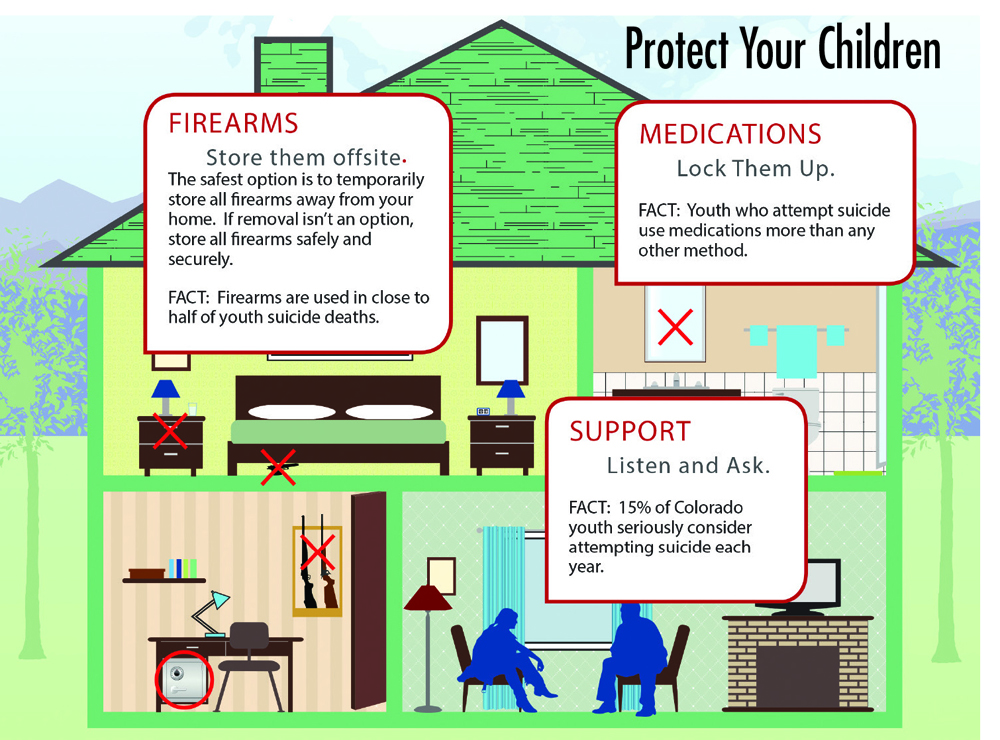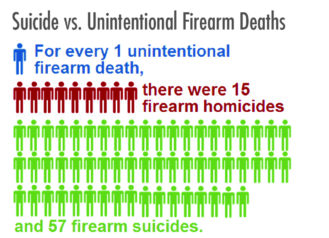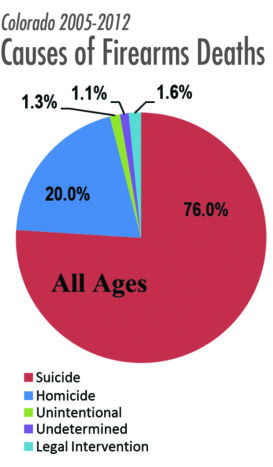
Illustration by Harvard Injury Control Research Center.
As he begins a suicide prevention training on a chilly Saturday morning, James Gallanos emphasizes “If you don’t remember anything else, remember that if you feel something in your gut, or something doesn’t feel right, and you feel someone may be thinking about suicide, it’s ok to ask. It’s not comfortable. It doesn’t feel good to ask; you may be scared to ask the question and you may be worried about how the words are coming out and how that may be perceived by the other person, but the most important thing is that you ask.”
Approximately every 8 hours, someone dies of suicide in the state of Colorado. Suicide is the leading cause of death for children ages 10-14 and the second leading cause of death for those ages 15-44 within our state. “These are preventable deaths,” says Gallanos, Colorado National Collaborative Coordinator for Violence and Injury Prevention with the Colorado Department of Public Health and Environment.

There are fewer than 10 unintentional firearm deaths annually in Colorado—58 occurred from 2005 through 2012.
Colorado Violent Death Reporting System (CoVDRS), Health Statistics Section, CO Dept. of Public Health and Environment, 03JAN2014.
A host of factors may lead someone to believe that suicide will end the pain they are experiencing. Though a concerned friend or relative cannot take away that person’s pain, they can be present, offer them hope, and by reaching out, break the chain that leads to a suicide attempt. Many people fear asking the question will impel someone to take that step, but Gallanos says it does not.
Intervention and treatment are overwhelmingly successful in preventing suicide and helping those who have hurt themselves to recover. “Most people recover from suicidal thoughts or behaviors,” Gallanos says. “It doesn’t mean they won’t attempt again or that they won’t face mental health challenges,” but with the right resources and supports in place, about 90% of individuals move past suicidal thoughts and behaviors.
Gallanos recommends finding a private and unrushed setting to ask the person you’re concerned about, “Are you thinking of hurting yourself?” You may warm up to this by asking first, “Have you been unhappy lately?” This is not ever an easy conversation, but in many instances, listening and offering hope can help shift the person’s belief that suicide is a solution. “Most people don’t want to die; they want an end to their pain,” Gallanos says. Wording is important when asking someone about their feelings. Do NOT say “You’re not suicidal, are you?” or “Promise me you won’t try to kill yourself.”

Graphic by CoVDRS
Your willingness to listen may rekindle hope. When you have that difficult conversation with someone you’re concerned about, it’s essential that you also encourage them to get help. You may offer to accompany them to get help or call the crisis line together.
People who attempt suicide frequently exhibit one or more of these signs: talk of hopelessness or suicide, behavioral changes (withdrawing from friends, family or activities; greater reliance on drugs) and mood changes (depression, anxiety, or irritability). According to the Centers for Disease Control (CDC), for each adult (18 and over) suicide, “there are about 30 adults who reported making a suicide attempt.”
Colorado is creating a comprehensive suicide prevention system with the goal of reducing the suicide rate by 20% by 2024. Children’s mental health programming received a recent boost from a $2.8 million grant from the Attorney General’s office in October 2018. The grant will support Partners for Children’s Mental Health (PCMH), led by Children’s Hospital Colorado, to “improve the delivery of care and engage with kids earlier to prevent mental health problems from escalating to emergencies.”
Attorney General Cynthia Coffman shares a personal connection to the issue as she reflects on two high school friends. Though one friend’s death was attributed to an accidental gunshot, she recalls that he did not feel accepted by his family due to being gay, and she believes it was in fact a suicide. “He has stayed with me all these years…and another friend with sexual identity issues made an attempt as a senior in high school. These experiences had a profound impact on me.” In Colorado and nationally, LGBTQ youth are at greater risk for suicide due to bullying and lack of support.
The Attorney General’s office oversees the statewide Safe2Tell program that allows anonymous reporting of safety concerns. In the past four years, suicide intervention tips have been the number one tip received by Safe2Tell, allowing for intervention and prevention. “We want to focus on addressing the problem upstream and also reach children as early as elementary school,” she says.
Reducing the suicide rate, however, may ultimately require not only additional mental health resources and prevention training, but reducing access to firearms. The CDC affirms that firearms are the most common method of suicide nationally. In Colorado, almost half of suicides are the result of firearms, and many national studies demonstrate a link between firearm access and suicide. Harvard University’s School of Public Health explains the connection: “Guns are more lethal than other suicide means. They’re quick. And they’re irreversible. About 85% of attempts with a firearm are fatal: that’s a much higher case fatality rate than for nearly every other method.” Many of the other suicide attempt methods have case fatality rates below 5%.
Will Coloradans ask their legislators to tackle the problem by passing safe storage laws?



0 Comments